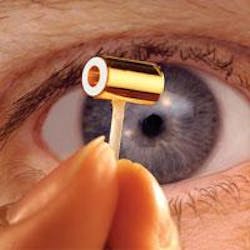Inertial Fusion: NIF hohlraum experiments yield first light

Initial “hohlraum” experiments on the National Ignition Facility (NIF) at Lawrence Livermore National Laboratory (LLNL; Livermore, CA) have validated computer simulations and theoretical projections related to the plasma and x-ray environment necessary to achieve ignition, according to researchers. (A hohlraum is small hollow sphere that converts laser light to x-rays to compress the fuel within it). The experiments, which involved activating the first four laser beams in NIF to measure laser-beam propagation in long-scale plasmas with lengths of gas-filled ignition hohlraums (gold-plated cylinders), demonstrated hohlraum performance limits consistent with simulations and analytic modeling for both low and high plasma-filling conditions.
One of NIF’s unique characteristics is the ability to provide long, steady laser drives with variable pulse lengths, up to 20 ns. In the hohlraum experients, 2-ns flattop UV laser pulses from the four beams (about 8 × 1012 W) were fired at a series of hohlraums of different sizes, each with a single laser entrance hole on one end, to test radiation temperature limits imposed by plasma filling (see figure). According to lead author Eduard Dewald, the experiments—which were performed in September 2004 but are described in a Nov. 18, 2005, Physical Review Letters article—produced radiation temperatures in agreement with hydrodynamic simulations and with an analytical model that includes hydrodynamic and coronal radiative losses. The measured x-ray flux showed signatures of filling that coincide with hard x-ray emission from plasma streaming out of the hohlraums.
Dewald and colleagues point out that their results can be extrapolated to higher laser energies by applying a simple analytic model for radiation-temperature limits. They believe that although the initial experiments were limited to the first four NIF beams—each of which only lasted about 9 ns—and only 1% of NIF’s ultimate 1.8-MJ output, future hohlraum experiments will be hotter, larger, and of longer duration when all of NIF’s 192 beams are fully operational. Eventually, the deuterium-tritium fuel capsule will be placed inside a larger hohlraum and all 192 beams will heat the interior of the hohlraum, through holes on both ends, creating x-rays that ablate and implode the capsule to ignition.
The initial series of experiments was the first hohlraum campaign on NIF and part of a larger four-campaign effort, coordinated by LLNL’s Nino Landen, and involving researchers from LLNL, Los Alamos National Laboratory, the United Kingdom’s Atomic Weapons Establishment, and General Atomics.
Kathy Kincade | Contributing Editor
Kathy Kincade is the founding editor of BioOptics World and a veteran reporter on optical technologies for biomedicine. She also served as the editor-in-chief of DrBicuspid.com, a web portal for dental professionals.